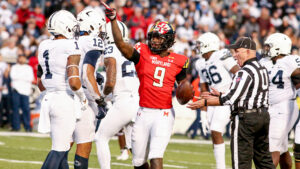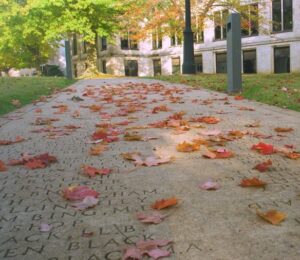Nathaniel Whitfield The university and the prison exist as metaphors and metonymies. As part of the Underground Scholars Initiative and UCLA's Prison Education Program, we are entangled in both as concepts and institutions in varying degrees and intensities. I have been thinking about our relationship with and within the prison logic of these institutions, since we are embedded in their discursive, social, psychological, material and embedded effects, and how these are embedded within us.
Alberto Lule I was imprisoned for about fourteen years, and the need to go back to education was probably the main concern I had when I was released. I started at the community college level and then transferred to UCLA. While spending time there as an art student, I began to wonder why I felt so comfortable walking around campus after fourteen years in prison. The mere fact that the campus even had this title of "institution" … I grew up knowing that as the word for prison, as in correctional institutions, before I knew that it was also a name for UCLA or any other institution of higher education. I don't think it's a coincidence. I grew up in the Santa Barbara area, which is not really known for being like the neighborhood; It is not really a slum or run-down neighborhood. I grew up in a working-class Chicano town called Goleta where there were a lot of police. For me, the whole idea of being confined starts in our own neighborhoods. When I went to the good parts of the city, they automatically pointed me out; They detained me or would ask me questions. If you were in a completely white neighborhood, and if you weren't there to trim the hedges, they really wanted to know why you were there. They saw me as if I was off limits or out of place. Even on campus I get certain looks, certain questions. On campus, I am often asked if I work there. I am a little older; I am a non-traditional student. But the fact that I align myself with someone who works there is because a lot of the maintenance people are Latino. Why do people automatically assume that all brown people are janitors? It's almost as if there are institutions created for people of color and there are institutions created for white people. In society, you are included in these categories. Its structures are invisible, they are not delineated for you, but they enclose you. In the place where he was physically confined, the prison, most of the people were black or brown. One of the first things I noticed when walking on a college campus, compared to walking through the prison yard, was that there are similarities. There are guidelines, there are protocols. The environment controls you.
NW You mention that confinement works here at the level of identity, but the mechanisms of imprisonment are still in play. Confinement has expanded from the prison site not only to the geographical space beyond, but also as a psychosocial space. It also relates the idea of enclosure, and what Marx calls primitive accumulation, that moment of colonial encounter that is crossed by violence and domination. There seems to be a relationship between the enclosure of the common land, the enclosure of social relations, and the enclosure of knowledge within the university. All of these are confinement structures in that sense, which function in a similar but different way.
Savannah Ramirez I think when we talk about land, it is important to recognize that UCLA is built on stolen land. It belongs to the Tongva people. Alberto mentioned that our neighborhoods are hyper-controlled. That is not happening by mistake. At UCLA we have a center designed to investigate what we call "Million Dollar Hoods." We spend more on incarceration than on education. If the state budget is supposed to reflect our values, then why, in the City of Los Angeles, is more than 54% of its annual budget spent on surveillance? At the same time, there has been great success recently with the passage of Measure J, which reallocates an additional portion of the Los Angeles County budget to community investments and alternatives to incarceration.
The Morrill Act of 1862, signed by President Abraham Lincoln, granted 79,461 parcels of Indian land, approximately 10,700,000 acres, to 52 land grant universities to fund their donations. (The United States also claimed more land through treaties, land transfers, or confiscations.) The Morrill Act worked by converting land taken from 245 tribal nations into seed capital for higher education – donations raised equal to $ 495 million in 2020 dollars. Image from Land-Grab Universities, 2020 (project by Robert Lee, Tristan Ahtone , Margaret Pearce, Kalen Goodluck, Geoff McGhee, Cody Leff, Katherine Lanpher and Taryn Salinas).
.
NW One of the tasks that seems to be being considered is to draw a map of the genealogies of power. Especially considering how public agencies, such as education and health, are absorbing more and more police functions, while many institutions of organized violence, such as the police and prisons, are simultaneously absorbing social functions. I am also thinking about how the prison as a space-time organization extends beyond the prison as a place of confinement. Part of the work consists of locating and thinking about what fixes subjects in such devices of domination, discipline and control. That is why I suppose that the idea of the university as a blank space and the prison as an institution to control the black and brown bodies that Alberto spoke about feels like an important frame. One could then question what control mechanisms the university exercises over bodies and what type of racialized subjectivity it constructs
.
AL You can also think of other spaces. Many black and brown artists would end up at the cultural center rather than the white cube gallery. And many of the people who make millions of dollars from artwork are rarely people of color. It's kind of like why have that space? Why not create an all-encompassing art space? It all goes back to segregation and Jim Crow laws where you have colored bathrooms and white bathrooms. That kind of thing still exists, but it's better camouflaged; it is not labeled like that. Those are all things that begin or began in otherness.
Rosie Rios I remember the first time I went to a prison, for one of my classes through the UCLA Prison Education Program. I went to the Barry J. Nidorf Juvenile Detention Center and couldn't believe how much it looked like my high school. It does something to you when you can recognize your high school in a prison. There is also the conduit from school to prison, where excessive surveillance and zero-tolerance policies in underserved communities do not lead to higher education, or careers, but to jail. And then for the few of us who can end up in these spaces to not be treated with respect… It reminds me how during the #blacklivesmatter 2020 uprisings in Los Angeles, UCLA offered Jackie Robinson Stadium to the police. It was basically a prison or a jail; a place to keep people arrested, to detain them. And don't even make me talk about the University of California Police Department (UCPD) and how they continue to profile, harass, and arrest students who are accepted and are part of the UCLA community.
Image of a protest at UCLA's Jackie Robinson Stadium on November 1, 2020 at the site used by LAPD to arrest #BLM protesters on June 1, 2020. The protest was organized by campus organizations Cops off Campus Coalition, No UCPD Coalition, Divest / Invest UCLA Faculty Collective along with Black Lives Matter LA, LA CAN, Stop LAPD Spying Coalition, WP4BL, Ground Game LA, Ktown for All, NOlympics LA, People's City Council, Anti-Eviction Mapping Project, Westside Local of the LA Tenants Union and Justice LA.
NW That reminds me of the protest banner placed under the "Champions are made here" sign that was unveiled during a stadium protest that read "Prisoners are made here." Unfortunately, this is just one of the many ways in which the university aids and incites state violence, how they are structurally complicit in the creation of prisoners.
AL I've had these experiences myself growing up, but now I'm re-experiencing them as the parent of a fourteen-year-old boy who goes to high school. One day we dropped him off at school when they were calling on the PA system and he said, "Oh man, there goes the prison megaphone again." I turned around and said, "What did you just say?" He said it's like the ones they had when he visited me. He also said that when he went to detention they would call the dean of the school the principal because he treats them as if they were prisoners; He gives the students numbers, and they are required to walk so that all the children at recess have to look at them. They are being exhibited, the same thing that happens to people when they go to court, when they enter in shackles so that the public can know who the people are who are in trouble. These are all little things, little performative details that add to the actual physical appearance of the school. On another occasion his headphones were taken from him because he was wearing them in class, and the teacher said he can get them back at the end of the day. But then at the end of the day, she just left, so he took his headphones from his desk and left. The next day they accused him of stealing, of a thief; that the headphones were the property of the school. When we had our conversation between teachers and parents, I asked them why they called him that, those words, that terminology that is used is installing things in him. He is being labeled and treated as a criminal. When I went to detention as a child, and then when the police arrested me, I already knew the word. I knew that meant I was going to be there for a while, and then they were going to let me go, hopefully.
NW I have never experienced something like this, but speaking of a body that is positioned within certain dispositions of time, space and movement, within certain dominance logics that act on it reminds me of The concept of the body Michel Foucault's docile in Discipline and Punishment which points very specifically to all this. It describes exactly what you have already mentioned: the division of time, the imposition of language, etc., which constantly coerce, act and exert power over the body. In this sense, power not only subdues people but also constitutes subjects. In the process, they develop a sense of self-knowledge; build your identity from within and from without. Confinement is a process; it is confined to this identity that imposes itself on the self, but which also comes from within the self.
AL It is almost as if they are adapting people so that when they finally arrive at the penitentiary they automatically know: “I have always been here, I have always been me, I have always been who I am.” When I left those spaces And I went into the higher education space, I saw the same kind of system, only now it's not so much a discipline system, but a privilege system. The same mechanisms were there, but they worked in reverse. They were there to administer privileges instead. to administer discipline.
NW I wonder how this administration of privileges is linked to how the university creates a workforce, that neoliberalism needs to serve the state and the market, how privilege and whiteness are linked to that and how universities mold subjects to operate within those parameters. The explicitness of this is present in how universities sell themselves with the degree of success of students based on the type of job they will get later. Universities are literally classified according to their ability to turn students into workers.
Image of a protest at UCLA's Jackie Robinson Stadium on November 1, 2020 at the site used by the LAPD to stop to the #BLM protesters on June 1, 2020.
RR When I was a student at UCLA, I took a course called “Disruption of the pipeline from school to prison” taught by Bryonn Bain and Pedro Noguera. It was the first UCLA class to enter Barry J. Nidorf. During that class we did this workshop called “Dear Teacher,” where we reflected on how interactions at the elementary, middle and high school levels impact the way you think about yourself and see your future. When working with incarcerated students, the suggestion was to write a letter to someone at the school: their teacher, counselor, even the school principal. What would you say to them? A lot of people said things like "I wish you hadn't told me I couldn't do it" or "I wish you had been more understanding of what was going on"; "I wish you knew what's going on at home and that's why I was struggling and couldn't focus." We created an anthology of these lyrics, and our goal was to give it to people who work in schools so they could better understand their role and the impact they have on students. When I was in high school, I remember my counselor telling me that I would be lucky if I wasn't pregnant in my senior year. Those are just words, but they have an impact. I could have internalized them, but being continually resistant to those things is not only stressful but exhausting.
SR It reminds me of the term "desertion" and, at the other extreme, "expulsion". Students are often unable to stand up for themselves, because when they do, they are challenging someone who is supposed to have power in the classroom. Educators must understand the needs of their students, as well as the needs of their communities, because the school is only one part. It is also happening outside of school.
RR People may have great intentions, but if you don't have a broader understanding of where the community you are serving is, what they are going through, then you may end up causing more harm than good.
AL Many of my works of art deal with the problems we have talked about. When we criticized in class, my work was silent. It was a very bad reality check. I realized that my fellow students who haven't walked in those shoes have no idea what I'm talking about. When they spoke, he was more understanding than empathetic.
RR The importance of including the voices of those directly affected is not just because we need to focus their voices. We should. But it's important because you never know how these kinds of projects can also help incarcerated students.
AL I wonder where exactly we see this conversation going.
RR Do we want to provide suggestions for something? Just so it doesn't look like trauma porn.
SR It is very important for us to highlight the work. Often times, it is the students who have been directly affected by these oppressive systems who hold these conversations and are willing to put in the effort. And in addition to being students in these spaces that are not made for us, we are also organizers, without compensation for our time. Then, at the opposite extreme, someone else's research sees us as subjects, and they are the ones who are benefiting, obtaining credits and compensating.
NW Michelle Brown speaks of the criminal spectator, in which technologies and the means of investigation, of analyzing, of looking create distance, which is violent because the prison logic themselves are linked to this process of distancing. In this sense, the university constitutes us as subjects of intellectual distancing
.
RR It is important to recognize that exposing and talking about what you experienced is not an easy thing, even though we have been through many times, I feel a responsibility for myself, my community and my family. get involved and keep speaking out against injustices and these oppressive systems. But at the same time, I feel like we need to give more. We need to provide access and resources. That is why the work of the Penitentiary Education Program is so important, in the organization of its events and discussions where control and moderation of the narrative moves away from people who have never experienced these things to people who have. This, in my opinion, is an example of the abolition of structures and systems where we are no longer just subjects, but creators and analysts of our own marginalization.
×
Confinement is a collaborative exhibition curated by gta exhibitions and e-flux Architecture, with the support of Adrian Weiss Stiftung and the ETH Zürich Foundation.
Alberto Lule graduated from the UCLA School of Art and Architecture in 2020 and is co-chair of the Underground Scholars Initiative.
Savannah Ramirez is a graduate student in public policy at the UCLA Luskin School of Public Affairs and a Bunche fellow at the Ralph J. Bunche Center for African American Studies at UCLA.
Rosie Rios is a UCLA alum and previously worked for the UCLA Prison Education Program. He is currently a graduate student in social work at Columbia University.
Nathaniel Whitfield is an artist, writer, professor, and MFA candidate at UCLA, as well as a researcher for the UCLA Prison Education Program.






Be First to Comment